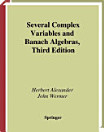Potential Theory
มิ.ย. 2013 · Springer Science & Business Media
eBook
149
หน้า
reportคะแนนและรีวิวไม่ได้รับการตรวจสอบยืนยัน ดูข้อมูลเพิ่มเติม
เกี่ยวกับ eBook เล่มนี้
Potential theory grew out of mathematical physics, in particular out of the theory of gravitation and the theory of electrostatics. Mathematical physicists such as Poisson and Green introduced some of the central ideas of the subject. A mathematician with a general knowledge of analysis may find it useful to begin his study of classical potential theory by looking at its physical origins. Sections 2, 5 and 6 of these Notes give in part heuristic arguments based on physical considerations. These heuristic arguments suggest mathematical theorems and provide the mathematician with the problem of finding the proper hypotheses and mathematical proofs. These Notes are based on a one-semester course given by the author at Brown University in 1971. On the part of the reader, they assume a knowledge of Real Function Theory to the extent of a first year graduate course. In addition some elementary facts regarding harmonic functions are aS$umed as known. For convenience we have listed these facts in the Appendix. Some notation is also explained there. Essentially all the proofs we give in the Notes are for Euclidean 3-space R3 and Newtonian potentials ~.
ให้คะแนน eBook นี้
แสดงความเห็นของคุณให้เรารับรู้
ข้อมูลในการอ่าน
สมาร์ทโฟนและแท็บเล็ต
ติดตั้งแอป Google Play Books สำหรับ Android และ iPad/iPhone แอปจะซิงค์โดยอัตโนมัติกับบัญชีของคุณ และช่วยให้คุณอ่านแบบออนไลน์หรือออฟไลน์ได้ทุกที่
แล็ปท็อปและคอมพิวเตอร์
คุณฟังหนังสือเสียงที่ซื้อจาก Google Play โดยใช้เว็บเบราว์เซอร์ในคอมพิวเตอร์ได้
eReader และอุปกรณ์อื่นๆ
หากต้องการอ่านบนอุปกรณ์ e-ink เช่น Kobo eReader คุณจะต้องดาวน์โหลดและโอนไฟล์ไปยังอุปกรณ์ของคุณ โปรดทำตามวิธีการอย่างละเอียดในศูนย์ช่วยเหลือเพื่อโอนไฟล์ไปยัง eReader ที่รองรับ





